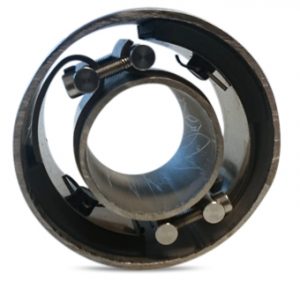Double wall pipe design
Double wall pipe design is not rocket science. However, it is more complicated than designing piping arrangements for traditional single pipe systems. In the prefect world, a double wall piping system could be treated as a single pipe system, but in practice there is often a neglected, but incredibly important, deviation in the design conditions such as temperature & pressure, between the outer pipe and the inner pipe. Many producers have recognized this fact, and offer products that have been developed to counteract these deviations. Cryogenic piping is particularly sensitive, particularly is the liquids in the inner pipe are often hazardous, and require double pipe both for safety, and for the different forms of insulation available.
The most sensitive part of a double wall pipe system is the method of support for the inner pipe. If the inner pipe is not correctly supported, then it is highly likely that at some point in the lifetime of the double wall piping system, excessive and repetitive thermal displacements of the inner pipe will eventually lead to premature failure of pipe supports. Particularly if compensation for these movements isn’t considered correctly. Therefore it is typical to include compensation mechanisms in the inner piping itself to allow for all these displacements. This has traditionally be in the form of compensator bellow welded into the piping itself, or U bends in the piping. It is also possible to offer an inner pipe with extremely low thermal expansion coefficients, in which case the piping may “take care of itself”, however this is likely to be a less cost effective option. Displacements must be considered based on the minimum and maximum design conditions of the piping, and taking into account at every point in the piping system, particularly around bends.
An inner pipe support system consisting of welded joints only to the outer pipe is very time consuming to install, and leads to a fully fixed double wall piping arrangement, that is highly likely to fail prematurely. Furthermore due to weld shrinkage during installation of the piping sections, additional stresses can be introduced onto the inner double pipe support during installation, leading to premature failure, particularly on these unflexible systems. A flexible, more common inner pipe support system uses plastic sleeves to centralise the inner pipe, allowing axial sliding, and therefore unlimited axial movements of the inner pipe relative to the outer. It must be noted however that around bends problems can initiate, whereupon an axial displacement is translated into a radial displacement. As the plastic sleeve does not allow for any radial displacement, then compressive forces will push onto the plastic sleeve, leading to premature failure or distortion of the sleeve supports themselves. Therefore, a support offering both unlimited axial displacement, and a degree of radial displacement seems to be a good. In general the more flexibility that can be offered by the structure, the more robust it will become. This of course assumes that external forms of vibration are also taken into account.
It should also be noted that such supports have existed for some time, and are readily available from AF Pipes. When delivered with well documented specifications, the “flexible” inner pipe support can prove an asset to the double wall pipe design team. These flexible inner pipe supports may also offer additional flexibility for pipe routings, often with reduced piping dimensions when compared to traditional support regimes, which reduces material and welding costs. It is important to note that such flexible inner pipe supports have to be accurately located and installed according to product specifications, and specifically installed at the correct radial angle, so they work in the correct direction relative to the radial displacements. If not installed correctly, premature failure may be expected through excessive stress, or cyclic stresses. Incorrect installation can also lead to metal to metal contact on the outer pipe, which is also undesirable.
It is also absolutely essential that the flexible supports are designed for the application, and produced with exactly the correct materials to allow for full flexibility and robustness. AF Pipes supplies accurate material certification, and ensures quality of supply throughout the production process. Just small reductions in material quality will result in premature failures of these support types, as they are designed with very specific and high quality material specifications.
The flexible inner pipe support concept has the potential to improve many of the parameters of double wall pipe design, whilst decreasing the installation complexity. The flexible inner pipe support is very simple to install and offers increased level of reliability due to the in-built compensation affects for misalignment of piping sections during installation, which is extremely common. Depending on the exact piping dimensions, and therefore inner pipe support size, it may be preferential to consider the flexible inner pipe support as an axial support, with limited radial freedom. This of course depends on the exact specification of the double pipe support chosen, but this can be considered the most robust method of designing the double wall pipe installation.


